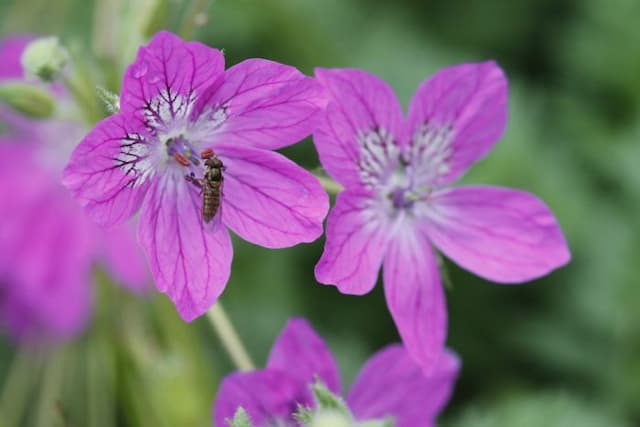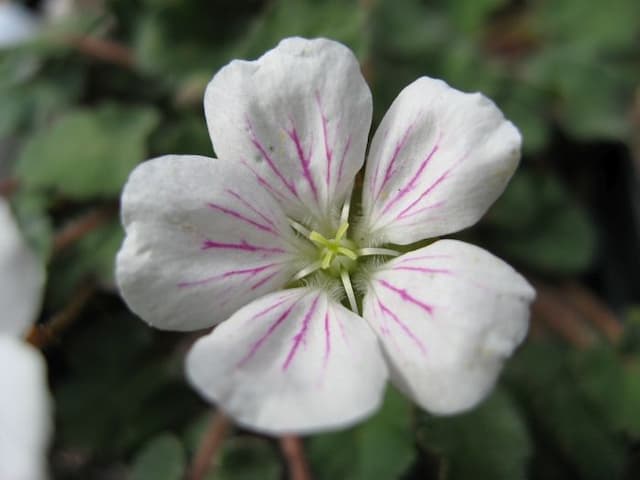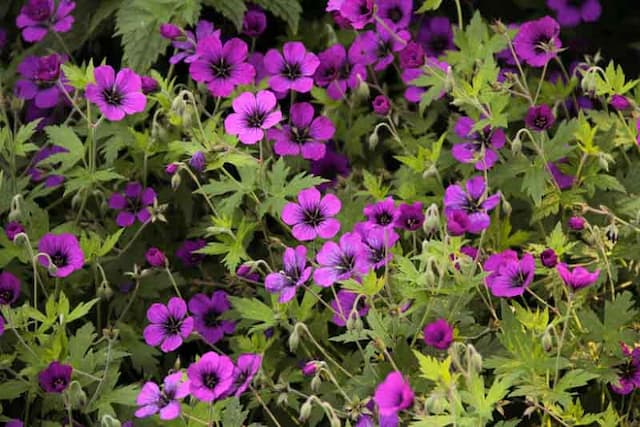Geranium Pelargonium 'Polka' (U)

ABOUT
The plant known commonly as garden geranium 'Polika' is a visually striking perennial that is popular for its showy and vibrant flowers. Its blossoms exhibit a unique pattern, typically two-toned with a base color often pink, red, or white contrasted with darker markings or striations radiating from the center. The flowers are borne in clusters atop sturdy stems, emerging above the foliage for a captivating display. The leaves of the geranium 'Polka' are equally attractive, providing a lush backdrop for the bright blooms. They have a rounded shape with distinct scalloped or lobed edges, often exhibiting a dense and velvety texture. The foliage tends to be a rich green color, sometimes with a zonal pattern or darker patches. The overall presentation of the geranium 'Polka' is charming with its harmonious balance of floral and leafy elements, making it a favored choice for gardeners looking to add a pop of color and texture to their space.
About this plant
 Names
NamesSynonyms
Geranium, Polka Geranium
Common names
Pelargonium 'Polka' (U).
 Toxicity
ToxicityTo humans
The common name for Pelargonium 'Polka' is geranium. Geraniums are typically not poisonous to humans, and there are no severe toxic effects known for ingesting parts of the plant. However, some people may experience mild irritation or an allergic reaction if they have sensitive skin or allergies to the plant. If ingested, it might cause minor symptoms such as nausea or an upset stomach in some individuals, but this is not common.
To pets
Geraniums are generally considered to be toxic to pets, especially cats and dogs. If ingested, the geranium can cause vomiting, diarrhea, depression, anorexia, and dermatitis in pets. The most concerning potential toxin in geraniums for pets is geraniol, along with linalool, which are found in the essential oils of the plant. Symptoms of poisoning can vary in severity, so if a pet ingests geranium, it is important to contact a veterinarian.
 Characteristics
CharacteristicsLife cycle
Perennials
Foliage type
Evergreen
Color of leaves
Green
Flower color
Pink
Height
1-2 feet (30-60 cm)
Spread
1-2 feet (30-60 cm)
Plant type
Herb
Hardiness zones
10
Native area
South Africa
Benefits
 General Benefits
General Benefits- Easy to grow: Pelargonium 'Polka' is known for being easy to maintain and can thrive with minimal care, making it ideal for both novice and experienced gardeners.
- Attractive foliage: The plant boasts unique and variegated leaves that add visual interest to any garden setting or as a houseplant.
- Vibrant flowers: It produces colorful flowers that can brighten up both indoor and outdoor spaces.
- Long blooming season: The blooming period of Pelargonium 'Polka' extends over several months, providing a long-lasting display of flowers.
- Drought-tolerant: Once established, this plant is relatively drought-resistant, making it suitable for xeriscaping and water-wise gardens.
- Container friendly: This plant is well-suited for pot culture, allowing for versatility in placement on patios, balconies, or indoors.
 Medical Properties
Medical PropertiesThis plant is not used for medical purposes.
 Air-purifying Qualities
Air-purifying QualitiesThis plant is not specifically known for air purifying qualities.
 Other Uses
Other Uses- Artistic Inspiration: Geranium 'Polka' stimulates creativity and can be used as a subject for painting or photography, capturing its unique foliage and blooms.
- Teaching Tool: Educators can utilize Geranium 'Polka' to teach botany and plant lifecycle to students due to its distinct features and growth patterns.
- Scented Sachets: The leaves of Geranium 'Polka' can be dried and used in scented sachets to naturally perfume drawers and wardrobes.
- Decorative Potpourri: Dried blooms and leaves of the Geranium 'Polka' can be mixed into potpourri arrangements for a subtle, natural fragrance indoors.
- Plant Companionship: Geranium 'Polka' can be grown alongside vegetables like tomatoes and peppers as companions to deter certain pests.
- Fabric Dyeing: The flowers and leaves of Geranium 'Polka' may be used in the natural dyeing process to impart color to fabrics.
- Craft Projects: Pressed or dried Geranium 'Polka' flowers can be used in craft projects, such as handmade cards or bookmarks.
- Table Centerpieces: Fresh Geranium 'Polka' flowers and foliage can be arranged as part of table centerpieces for events and dinners.
- Holiday Decorations: Geranium 'Polka' can be incorporated into wreaths and garlands for festive holiday decorations.
- Culinary Garnish: Edible flowers from the Geranium 'Polka' can be used to add a splash of color as a garnish for salads and desserts. *
Interesting Facts
 Feng Shui
Feng ShuiThe geranium is not used in Feng Shui practice.
 Zodiac Sign Compitability
Zodiac Sign CompitabilityThe geranium is not used in astrology practice.
 Plant Symbolism
Plant Symbolism- Comfort: Pelargoniums, commonly known as Geraniums, are often associated with comfort due to their pleasant scent and homey appearance, which can create a cozy and comforting atmosphere in a home or garden.
- Friendship: Geraniums have been a traditional symbol of friendship, often given as gifts to express closeness or to celebrate a long-lasting bond.
- Health: The geranium is sometimes symbolized as a plant of health, as some varieties have been used in traditional medicine and are thought to promote a healthy environment when grown indoors.
- Happiness: The bright and colorful flowers of geraniums are often associated with happiness and positive emotions, making them common plants for cheering up living spaces and gardens.
- Peace: With their soothing colors and gentle appearance, geraniums can symbolize peace and tranquility, often used in gardens and spaces designed for relaxation and reflection.
 Water
WaterGeraniums, such as the Pelargonium 'Polka', prefer to be watered thoroughly but infrequently. Water the plant when the top inch of soil feels dry, which typically happens once a week during active growth periods. Use lukewarm water and pour it directly onto the soil until you see excess water drain out of the bottom of the pot; this helps ensure the root ball is adequately moistened. Depending on the size of your pot and the indoor conditions, you might use around half a gallon of water every watering session. During winter, when the plant is not actively growing, reduce the watering frequency to every other week or when the soil is dry to touch.
 Light
LightGeraniums thrive in bright, indirect sunlight. The ideal spot for a Pelargonium 'Polka' is near an east or west-facing window where it will receive plenty of light without the harsh direct rays of the sun, especially during the heat of the day. However, they can also tolerate direct morning sunlight, which is gentler. Ensure that the plant receives at least six hours of light per day for optimal growth and flowering.
 Temperature
TemperatureGeraniums like Pelargonium 'Polka' do best in temperatures between 65 and 75 degrees Fahrenheit during the day and should not be exposed to temperatures below 50 degrees Fahrenheit, as they are sensitive to frost. They can tolerate up to about 80 degrees Fahrenheit, but high temperatures can stunt their growth. Providing good air circulation around the plant can help maintain a consistent temperature.
 Pruning
PruningPruning Geraniums like Pelargonium 'Polka' is essential to encourage bushier growth and more blooms. Pinch or cut back overgrown stems and deadhead spent flowers to promote new growth. The best time to prune heavily is in late winter or early spring before new growth begins. Regularly removing dead leaves and spent flowers throughout the growing season helps the plant to focus its energy on producing more blooms.
 Cleaning
CleaningAs needed
 Soil
SoilGeranium 'Polka' thrives best in a soil mix that is well-draining and fertile. A mixture composed of equal parts peat, perlite, and potting soil is ideal. The soil pH should generally be around 6.0 to 7.0, slightly acidic to neutral.
 Repotting
RepottingGeranium 'Polka' should be repotted every 1 to 2 years, or when it has outgrown its current pot. This will help the plant stay healthy and prevent it from becoming root-bound.
 Humidity & Misting
Humidity & MistingGeranium 'Polka' prefers average household humidity levels. It does not have specific high humidity requirements and can tolerate dry air, making it suitable for typical indoor conditions.
 Suitable locations
Suitable locationsIndoor
Place in bright, indirect light and water when soil feels dry.
Outdoor
Ensure full sun to partial shade and protect from frost.
Hardiness zone
10-11 USDA
 Life cycle
Life cycleThe life cycle of the Pelargonium 'Polka', commonly known as a geranium, begins with seed germination, where the seeds require warm temperatures and constant moisture to sprout. Following germination, the seedlings grow into juvenile plants and must receive adequate sunlight and water to develop fully. As the plants mature, they enter a vigorous vegetative state, producing distinctive leaves and branching stems. The geranium then reaches the flowering stage, where it produces clusters of colorful flowers that can be pink, red, purple, or white, often during the warmer months. After pollination, the flowers produce seeds, completing the reproductive cycle. If environmental conditions are unfavorable or the plant expends its resources, it will eventually enter a period of senescence, concluding its life cycle.
 Propogation
PropogationPropogation time
Spring-Early Summer
Propogation: The most popular method for propagating Pelargonium 'Polka', commonly known as geranium, is through stem cuttings. This is ideally done during late spring to early summer, when the plant is actively growing. A healthy, non-flowering stem of about 4 to 6 inches (about 10-15 cm) is cut just below a node with a sharp, clean knife or scissors. The lower leaves are removed, and the cut end can be dipped in rooting hormone to increase the success rate, though this is not strictly necessary. The cutting is then planted in a pot filled with a mix of peat and perlite or a similar well-draining medium. It's kept lightly moist and in bright, indirect light until it roots, which generally takes a few weeks. Once roots are established, the new geranium plant can be transplanted to a larger pot or into the garden.









![Cranesbill [Rothbury Gem]](/_next/image?url=https%3A%2F%2Fplants-admin.emdemapps.com%2Fimages%2Fplants%2F%2Fimages%2F604b6243984c2.png&w=640&q=75)